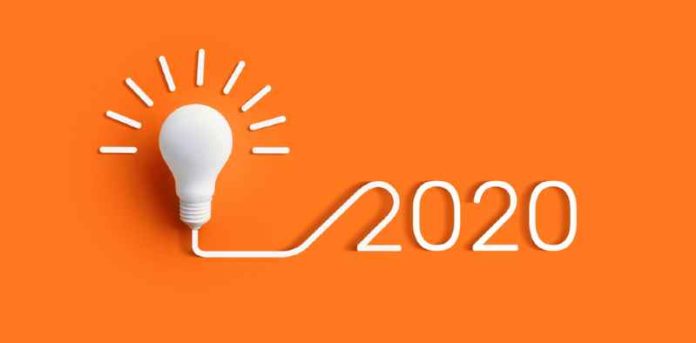What lies ahead for small business owners and entrepreneurs? Many I’ve talked to feel like they are living in a Dickens novel. It’s the best of times: The economy is going strong, driven, says Sharon Miller, managing director, head of small business for Bank of America, by consumer spending. She says, “according to Bank of America data, consumer spending is up 5.5% on $3 trillion worth of transactions, which will help drive momentum into 2020.”
It’s the worst of times: Many a small business are struggling with finding qualified employees to fill jobs, are baffled by the rapidly changing world of digital marketing and are facing numerous other challenges.
To get some answers I turned to business leaders, entrepreneurs and thought leaders to get their insights and perspectives on what 2020 (and the new decade) has in store for small business. Of course, there are no guarantees. But hopefully, as my friends at Fundbox say, these “trends bear a history and trajectory that demonstrate their value in guiding your company’s efforts—and ones you can “depend on to help gain a competitive advantage in 2020.”
Part 2 of 2
If you missed part 1, you can find it here.
Advertising
Peter Bordes, CEO, Kubient
Back to basics: Silos will open, fragmentation will be dissipated and programmatic will move towards its original mission to provide an open trading platform for buyers and sellers of advertising.
DOOH: Many don’t understand the impact DOOH (Digital out-of-home) will have. All of the features that are currently available on display, mobile and web with retargeting will be available in real-time on DOOH
Expect to see more targeting, more infrastructure and more open trading
The industry is cannibalizing themselves: There is way too much fragmentation and too many siloes. Aggregation is currently happening and will only continue to as advertisers/media companies are understanding they need a full stack solution.
2020 will bring consolidations and M&A to the overall adtech industry—or many companies will be weeded out.
Ad fraud: The Ad Fraud measurement model is flawed. For example, a recent report only measured a portion of the traffic, so fraud numbers are likely higher than they are purported to be.
Fraud prevention shouldn’t be an add-on, it should be baked into the platform’s advertisers use. Right now, advertisers only measure a portion of their traffic, or identify fraud retroactively when it’s too late.
Rhett Doolittle, CEO, Bluume
There will be a new company/platform to evolve in the advertising space for small businesses. The cost for Google, Facebook, Instagram and LinkedIn ads continues to increase and fails to show a return for small businesses. This provides a great opportunity for new technology to bring value to small businesses and consumers.”
Compliance
Chris Wayne, CTO, Yahoo Small Business
The world is becoming more regulated, and in 2020, small businesses will do something about it: The implementation of legislation to improve protection of personally identifiable information (PII) will continue to significantly impact e-commerce and e-commerce-adjacent industries. In 2018, the rise of GDPR forced companies to comply with strict new rules regarding the collection, storage and use of customer data and has since influenced how companies engage with their customers, the tools they use, and how they use them.
With compliance issues and regulations taking on greater importance and becoming increasingly complex, ‘Do It for Me’ (DIFM) services and applications to help manage GDPR compliance and other privacy laws will become critical to the e-commerce ecosystem. Since GDPR applies to all databases, marketing, sales, HR, and accounting, any way data is stored or processed falls under these strict regulations. Businesses are responsible for how and where their data is stored, and for small businesses or e-commerce companies using third-party software partners, this opens up a host of potential issues. Small businesses will increasingly turn to partners and managed service providers (MSPs) to handle these complex aspects of their business.
Small businesses may take this a step further and integrate a managed security service provider (MSSP) to uphold security in their organizations. MSSPs are particularly appealing to small businesses with limited budget, staff, or resources to maintain good cybersecurity practices.
Charley Moore, CEO, Rocket Lawyer
On the California Consumer Privacy Act (CCPA): “Like GDPR in Europe, CCPA is undoubtedly going to increase the cost of doing business in California and other places. New rules to comply with that will require investment on company parts in technology and know-how. Business owners need to budget for increased costs. In addition to increased compliance costs, CCPA opens up the potential for new litigation—another legal risk companies have to budget for. Any company that essentially has any sort of presence online is going to interact with personal information governed by CCPA, and as a result has new liability.
Customer Relationships/Experience
David Simon, SVP and Global Head of Small Business and Medium Enterprises (SME) Business, Visa
A positive customer experience can help to bring in more customers, increase sales, and create customer loyalty. Digital tools and services that simplify the shopping experience are important motivating factors for consumers when deciding where to shop. According to our research on the digital transformation of small and medium businesses, many SMBs have acknowledged such considerations—55% agree that innovative new ordering or payment services will have a positive impact on the business’s bottom line. However, only half of SMBs have tried services such as shipping/delivery, online order ahead, curbside pickup, and self-serve kiosks. In 2020, we will see a far greater number of SMB owners providing digital-related services such as the ability to shop in-store and online, buy online and return in-store, order ahead online, and free or same day delivery in order to stay ahead of the curve as it relates to the future of commerce. Beyond these online services, the adoption of custom digital dashboards for expedited automation and information share, accounting technology integration, and payment and spend controls will be integral to a modernized approach to running—and sustaining—a small business.
Dan Breeden, Strategic Partner Management, Yahoo Small Business
2020 will be the year of the ‘always-on’ small business: As companies like Amazon continue to set buyer’s expectations for customer experience, it has become necessary for small businesses to adapt in order to keep pace. Successful small businesses in 2020 will increasingly adopt technologies and practices that help support an ‘always-on’ customer communications strategy. Through a combination of automated support chatbots, 24/7 social media responses, and spreading staff hours to monitor email and phone lines beyond a standard workday, small businesses will appear always-on and always-there. Small businesses that are able to meet these expectations—whether through seamless customer experiences, persistent accessibility, immediate responses, and more—will be most likely to build a loyal following.
This will become particularly important in 2020 as we see a counter-current of online shoppers looking to purchase unique items or to do business with smaller local merchants that share their passions, social, or environmental alignment, or who work in support of pet projects and causes. This niche consumer mindset creates an opportunity for small businesses to connect with customers on a deep, personal level and to create differentiation in both products, services, and service delivery.
Rich Rao, Vice President, Small Business, Facebook
Businesses will lean more on messaging to deepen their customer relationships: As I’ve been on the road this year meeting with small businesses, no matter the location, whether a rural town in OK to Singapore, small businesses are increasingly using messaging to gain proximity and build relationships with their clients. Businesses are opening up digital presences and inviting in their customers to message with them—gathering feedback , testing new products and building their brand.
Meredith Schmidt, EVP and GM, Salesforce Essentials
Apps, technology, and social media are great equalizers for small businesses when it comes to customer experience. With so many apps and technologies to choose from, and options for every need and price range, small businesses can access simple yet productive tools for functions like marketing, customer acquisition, customer service and engagement. And as social channels continue to evolve, it’s easier than ever to reach your customers where they are and create lifetime customers and relationships.”
Kristen Bialik, Senior CX Analyst, Capterra
It’s important to take your customer experience strategy to the next level as consumers in stores expect more and more from businesses especially with the rise of technology and online shopping.
1—Develop customer personas to better identify CX needs: A customer persona is a finely honed profile of your best or target customer and should be as specific as possible to help you visualize their wants, needs, behaviors, and motivations.
Think beyond demographic information such as age, gender and income, and look toward your target customer’s values, opinions, aspirations purchase histories, service records, engagement on your website or social media profiles etc.
2—Build customer journey maps to better prioritize CX efforts: A customer journey map is an externally focused map of your customer’s experience through the full cycle of a particular journey. So it could start at the customer’s own awareness of a need and end with a product purchase, with steps for every interaction in between.
Try putting yourself in the customer’s shoes and imagine their actions and feelings along the way. By the end of the process, you should have a deeper understanding of gaps or flaws in the customer experience and your customer’s motivations, desires, and feelings throughout.
3—Create a Voice of the Customer (VoC) program to improve CX efforts: A VoC program captures and analyzes multiple types of customer feedback to identify customer experience areas that need improvement. As one of the core ways to better understand your customers, VoC programs enable organizations to follow one of the foundational pillars of strong CX.
Data sources for a VoC program can include customer complaints, customer surveys, employee feedback, company reviews, interviews, and social media. Through rich, diversified sources of customer feedback, VoC programs help companies better understand customer experience and sentiment.
Oz Etzioni, CEO, Clinch
2019 was the race for data. Now, brands need to figure out how to optimize the data they have and execute on it. You need to have a continuous understanding and communication between brand & consumer. In order to achieve this, brands need to break their silos, start building a customer experience hub to connect 1st and 3rd party data, and execute across all channels.
Rhett Doolittle, CEO, Bluume
More automation in customer relationship management has occurred, and it has spread to several industries including brick-and-mortar businesses. This will continue to evolve and become more prevalent for every industry type.
Marketing
Rosie Blake, CEO and founder, The Social Club
- A focus on relevant and authentic influencer content. Many brands end up paying for influencers that don’t drive results because they aren’t brand-relevant. Audiences are becoming more aware of sponsored content and authentic content will be the new driver when audiences are choosing influencers to engage with.
- A shift towards micro and nano influencers with smaller audiences but higher engagement rates. These influencers are more relatable to their audiences and generally result in a higher ROI.
- More focus on longer-term influencer partnerships and brand ambassadors than one-off posts
- The use of influencer platforms becoming more important in the drive for better ROI. In a new era where Instagram [may remove] likes, agencies and platforms are bridging the gap in influencer partnerships to make finding relevant influencers less time consuming and help to measure success.
- Brands will start merging their content and influencer budgets, and start using influencers to create their content instead of production in-house.
Heather DeSantis, CEO and founder, Publicity For Good
- Data is going to be king. Campaigns are going to be more targeted and specific because we are learning so much from it about our audiences.
- KPIs will become essential to client relationships. Clients and marketing teams are getting savvier with their campaigns and are going to want more tangible proof of where their monthly retainers are going.
- Earned media and paid media are very different, and it’s going to be more important for clients to receive earned media.
- Publicists are going to be taking a more personal approach to working with clients. Clients want to feel cared for by their PR professionals.
Brad Simms, CEO, GALE Partners
Invest in Addressable Marketing: We say this a lot: hunches are out, and insights based on actual behavior are in. The only way to effectively personalize your brand message at scale is to lead with intelligence, then back it up with data-informed creative. In 2020, we predict—or at least hope—that businesses will realize what they’re missing is a proper, data-backed addressable strategy that goes beyond driving leads and conversion, to actually acquire new audiences and telling compelling brand stories. We’re not saying that mass marketing isn’t effective; we’re saying that it’s not where to start anymore. Today, you have to invest in addressable marketing to succeed.
Lauren McGuire, president, Man Made Music
Brands will need a sonic personality: In 2020, all businesses and their brands will need a sonic personality. That personality may be delivered through short-form sound, their own voice or both. Brands will think about their sound as equal to their visual identity, as the importance of audio grows with increased browsing and purchasing through voice.
Retail businesses in particular and those in adjacent categories will focus on designing better experiences and easier transactions to lure people into their spaces. Music and sound is traditionally under-utilized, but its strategic use to create immersive environments will come into greater focus. As new tech like self-checkouts, robot assistants, and no check-out (like Amazon Go) is developed and introduced into brick and mortar, the impact of smart and strategic sound and music will be critical in driving adoption and reducing learning curves or confusion.
Andre Swanston, CEO and founder, Tru Optik
Gaming—Reaching the Unreachables: Advertising in video games will be a huge opportunity in 2020 for advertisers to reach the unreachables. The average gamer has an ad blocker, is not using Facebook, doesn’t watch linear television. Reaching a wide desirable diverse audience of millennials, Gen Z’ers and Gen X’ers, who were part of the video game boom, can be found playing video games and interacting with relevant advertisements.
Michal Borkowski, co-founder and CEO of Sales, Brainly
Brands not getting it right will be called out: If brands are going to take a stance (think, Nike’s support of Colin Kaepernick) they need to have the values to back it up.
Going Green
Krish Iyer, Director of Strategic Alliances, ShipStation
Sustainability in retail is a huge conversation when we look at how we, as a society, can reduce carbon emissions. In 2020, we will see brands take a step back and look at each piece of the supply chain individually—from sourcing materials to manufacturing to shipping (and returns) materials—and work to optimize processes in a much more eco-friendly way. On the consumer side, we’re already seeing shoppers become more environmentally conscious—veering away from some fast-fashion options and paying for sustainably-manufactured products and eco-friendly shipping. In 2020, we will see this trend grow, and we will see more and more brands adjust in order to stay competitive.
HR/Workplace
Don Weinstein, Corporate Vice President, Global Product and Technology, ADP
Trends Influencing the Future of Work: We are seeing a business-critical convergence of technology and data in the workplace. In 2020, companies will look to leverage customizable tech solutions that meet the needs of their organization, their teams, and their workers to provide a more engaging and productive work environment.
A team-based approach will change how work gets done.
- Organizations of all sizes need to break down siloes to unlock potential and create a culture of connectivity predicated on engagement and performance.
- HCM solutions have not been architected in a way that supports dynamic teamwork. Expect that to change. The future of work lies in a flat working structure that unlocks the potential of dynamic teams.
- The tight labor market will continue to fuel the war for talent, forcing employers to reevaluate their teams and seek alternative hiring solutions. Companies will increasingly look to meet their talent needs by supplementing their staff with highly specialized gig workers; former, returning workers; and retirees that can support nimble work.
Personalization will become paramount.
- Employers and workers alike will demand app-driven, consumer-grade HCM experiences—not monolithic software that is difficult to implement. Technology platforms will need to adapt to offer flexible options that companies, teams and even individual workers can configure.
- The worker experience will evolve through a confluence of emerging technology, artificial intelligence (AI) and machine learning (ML). The evolution of natural language processing and more conversational chatbots will help reduce time to complete tasks and aid in promoting user adoption
- With the rise of new fintech solutions for consumers, workers have grown more discerning about how and when they get paid. As a result, the pay experience will reach a new level of personalization, offering an easier way for workers to be paid, the way they want, anytime they want.
- Forward-thinking workplace perks, such as personalized, employer-driven financial wellness offerings will help workers manage their pay, savings and improve their financial well-being.
Compliance complexity will grow.
- Increasing regulatory demands throughout the world is sharpening the focus on a need for agile compliance solutions. To help companies navigate this landscape, HCM partners will need to deliver global localization—the ability to localize compliance tools that address changing policies, regulations and laws at all levels with ease.
- As organizations and teams continue to become more global—with workers logging in from around the world—businesses will be increasingly focused on uncovering new, compliant ways to support worker mobility, without creating unnecessary burden.
Today’s evolving workforce will require adaptable technology.
- Just as teams will become more agile, so will technology platforms. This shift will enable HCM providers to deliver best-in-class levels of system uptime and scalability.
- As more and more businesses move workloads to the cloud, expect the HCM industry to follow suit. Cloud-native platforms will receive favorability, as they eliminate maintenance windows, provide an open ecosystem approach, drive scalability and performance, and require less technical fluency from users so they can tailor worker experiences and create their own workflows.
- Companies will have greater access to technology that provides ever-evolving, personalized solutions to fit their organization. The ability to access a foundation designed for rapid change only further supports flexible, adaptable solutions that effectively respond to the changing needs of a company.
Rich Rao, Vice President, Small Business, Facebook
Small business owners will increasingly look for talent with digital skills: When asked about hiring needs in recent survey, 76% of businesses said that being proficient in the latest online tools and apps is important for some, if not many or all, jobs. As consumers increasingly use social networks to find and compare local goods and services, small businesses are rethinking which skills are necessary to be competitive and thrive in today’s world.
Jon Stross, President & co-founder, Greenhouse
The candidate experience will become a higher priority: 2020 will see the candidate experience—from application to onboarding—become a bigger focus for HR teams. Everything from regular touchpoints to better interview prep are major factors in how applicants perceive their candidate journeys. A poor experience can mean the loss of a qualified applicant, bad word-of-mouth for a [small business] and a general chilling effect on the overall quality of candidates over time. The best companies are getting the experience right, and we expect more companies will embrace that “cause and effect” dynamic in the new year.
Company culture will become more meaningful to attract talent: In a competitive hiring market, a strong company culture is a key factor for drawing top talent. And today’s candidates no longer care about free beer or ‘nap rooms’ in the office—they want to know that a company’s culture puts them first. That means increased transparency from senior leadership, better career advancement opportunities and more meaningful benefits (parental leave options, etc.) are now table stakes for candidates. 2020 will see organizations increase their focus on company culture initiatives to offer more significant perks that put the employee first.
HR execs will embrace data: HR will become more focused on data, and HR execs will need to be well versed in data analytics. The increasing importance of data in talent acquisition will, in turn, mean that talent teams add people who have expertise in parsing and understanding quantified data and how it applies to hiring. Expect 2020 to bring a shift in the traditional role of the HR exec to embrace data and data science, enabling them to have a stronger voice in shaping strategic decisions that impact people.
Mark Silverman, CEO, Amava
Statistics show that more than ever, baby boomers are working long into their golden years. As the workforce continues to age, experts predict that 25% of workers will be 55 and older by 2020.
- Flexible schedules. The 8-hours straight notion of full-time work is morphing and boomers are taking advantage of it. That might mean starting work at 7am, taking a fitness break for a few hours at 3pm and finishing up later in the day. Flexible schedules result in a happier, healthier and more productive workforce but supporting flexible schedules takes work.
- Gig economy. Gig work continues to be a source of flexible income for boomers. Whether they still work full-time and moonlight to help their kids or parents or they’ve moved on from careers but want to keep earning, many boomers are increasingly becoming gig economy workers. This is great news for companies and organizations that need to scale-up during peak times.
- Remote work. With conferencing tools ever-refining, the rules of work requiring regular facetime continue to change. [This] fits in with travel, caregiving and a more flexible, ‘work-on-the-go’ or nomadic lifestyle that many boomers seek.
- Running a small business. Boomers who’ve worked for others their whole careers are looking at ways to hang their own shingles. They are starting consulting businesses, mentoring others, investing in franchises and more.
- Mission-driven work. For many, the mission’s become the thing. Boomers are increasingly seeking out mission-driven paid work. They want to spend their time with companies that solve big problems.
- Working for benefits. A growing number of boomers are getting back into (or staying longer in) the workforce primarily for health benefits. As the cost of health care has soared, health and wellness costs have become one of the largest annual expenses for the aging population.
Opportunities
Sharon Miller, Managing Director, Head of Small Business, Bank of America
Wellness—making sure we have balance—is especially important for entrepreneurs. When you have less than 100 employees and you’re doing everything healthcare and wellness become very important.
There’s a big opportunity [here]—mental health providers are hard to find. There’s a shortage of services—and there’s a need for more.
Jon Fasoli, Vice President & Small Business Segment Leader, Intuit
Will the gig trend continue? The Future of Work and the gig economy will continue being debated into 2020 and beyond. People who work for themselves create 80% of new jobs, yet there is uncertainty about what the future holds and how far we are into this wave of change. Two areas where QuickBooks is focused on moving the needle for self-employed professionals are portable benefits and access to capital.
Andre Swanston, CEO and Founder, Tru Optik
There’s always an audience for FREE: While Netflix has cause for concern, free OTT services will not only survive, they will thrive as consumers look to supplement pay connected TV with free options.
Streaming audio is the new CTV: The amount of weekly listeners and consumer listening hours on streaming audio will surpass terrestrial radio. Podcasts and smart speakers are becoming the norm. This shift has massive ramifications for advertisers as they look to navigate the new digital, audio world
Retail/Commerce
Phil Grier, commerce engineer, Yahoo Small Business
Over the years, we’ve seen a blurring line between brick-and-mortar and e-commerce stores during the holiday shopping season. New data shows, due to changing consumer behaviours (online shopping is no longer concentrated on a single day) Cyber Monday is declining in importance as the majority of sales increasingly shift to all online.
An overview of holiday sales data, based on Yahoo’s e-commerce merchants, shows:
- 2017: Cyber Monday sales were 26% higher than on Black Friday
- 2018: Cyber Monday sales were 17% higher than on Black Frida
- 2019: Cyber Monday sales were 7% higher than on Black Friday
Yahoo’s merchants aren’t the only ones seeing a shift— earlier this month Adobe Analytics also reported that Black Friday has merged from a one-day sale to an extended weekend sale.
Merchants who are implementing intelligent designs to help customers find what they want and thus increase conversions are experiencing significant sales growth.
This trend will continue until Black Friday eventually outdoes Cyber Monday in sales, even for e-commerce-only merchants.
Charudatta Ganpule, Head, Retail Research Desk, Tata Consultancy Services (TCS)
Integration of brick-and-mortar and online retail—BOPIS: A hybrid form of commerce where shoppers can move seamlessly between physical and digital worlds of retail as they research products and make purchases is on the rise. This convergence of physical and digital retailing is clear with consumers searching online and buying offline; searching offline and buying online; or buying online and picking up in store (BOPIS). BOPIS helps consumers avoid shipping fees and get products faster, while providing retailers with potential opportunities to sell more and enhance the customer experience. This trend is driving traditional brick-and-mortar retailers like Walmart, Target and Best Buy to enhance their online functionality and offerings, while also pushing e-commerce retailers from Bonobos to Amazon to open brick-and-mortar stores.
Social shopping enhanced with better data utilization: The line between social media and e-commerce is becoming blurred, commonly known as Social Commerce. Instagram and Pinterest have helped pioneer social shopping with brands witnessing similar trends on Facebook. Primary drivers of social commerce’s success has been the shift of preference by Generation Z and millennials towards platforms like YouTube, TikTok, Snapchat, and Instagram. The key is short-form video content, which becomes the dominant form of online content. Depop, which closed $63 million in funding as social fashion app targeting millennials and Gen Z, is an excellent example of the convergence of social commerce and technology.
Responsive merchandising provides a competitive advantage: Consumers exhibit their preferences for styles, colors and patterns of products in store, while online they similarly click, pinch, scroll and search directly on retailers’ sites. Retailers can tap into this wealth of data about their shoppers’ preferences, their stores and the broader marketplace.
Responsive merchandising is about improving the experience in those micro-moments that pulse throughout the entire customer journey. Successful brands differentiate themselves with data-led initiatives that enable them to anticipate market shifts and be first with new products inspired by local purchase patterns.
Shift to non-traditional formats: Major retailers are transitioning from their original business model into non-traditional, typically smaller store formats that are varied to match the shifts in what, when, and where consumers want to shop. These non-traditional formats are temporary in nature, such as pop-up stores, mobile retail trucks, or flash websites existing for finite periods of time. Some current examples of pop-up store formats include holiday toys, fashion-show street sales via mobile stores, and urban bodegas with 30-day lifecycles featuring one-off products or unusual imports. Dollar stores and wholesale clubs lead the way in non-traditional sales gains.
Inventory management in becomes automated: In 2019, we saw some innovative robotics used for inventory management purposes in grocery stores. In 2020, this trend will continue to become more mainstream, as robotics and AI are paired to complete more mundane tasks for retailers. Back-end inventory management will be automated this way, and other infrastructural technologies will allow for retailers to optimize their inventory and make purchases orders without ever needing a human to lift a finger. This will free up the time for retail employees to focus on delivering exceptional customer experiences in-store.
5G will revolutionize retail: With 5G, ubiquitous connectivity will finally become reality and consumers will gain immediate access to more data. Consumers will be less restricted and more informed about the retailers and brands they want to support/purchase. 5G is also expected to hasten the transformation of smart/connected packaging and quick delivery with built-in sensors collecting real-time data ensuring internal package conditions for perishable items such as food and regulated items such as medications.
Greg Chapman, SVP of Business Development, Avalara
Marketplaces will continue to move from “Sell Through” to “Sell To”: Many marketplaces have already started selling more products directly to consumers. Given the increased tax compliance obligations being placed on marketplaces for third-party sales made through the platform, we can expect marketplaces to continue to move closer towards a “sell-to” approach as opposed to a primarily “sell-through” approach.
E-commerce platforms need to work with marketplaces or continue to be forced out: Over the past few years, we’ve seen consumers take a sharp turn toward a marketplace-first approach to online shopping. This shift in consumer habits coupled with the increase in online sales tax regulations will continue to make marketplaces an ideal channel for merchants to avoid the added cost of economic nexus laws. An added impact on this trend is that Very Small Businesses (VSBs) and Small and Medium Businesses (SMBs) could potentially move to marketplaces completely and abandon e-commerce to stay competitive and avoid compliance challenges. We should expect traditional e-commerce providers to start working closely with marketplaces or offering more “Amazon-like” experiences to stay relevant.
Omnichannel will become the norm and point-of-sale (POS) will become more connected into other channels: 2020 signals a new decade that will thrust millennials into the prime adult stage and bring Gen Z of college-age. As younger generations gain more control of buying power, businesses will be forced to adopt an omnichannel approach to provide more convenience while maintaining a seamless shopping experience from in-store to online to social media and beyond. To adopt a truly omnichannel approach, businesses will need to leverage technology that connects all POS touchpoints. The sharing of customer and transaction data across channels will be critical to providing a high-impact customer experience on every channel.
The honeymoon period for marketplaces is coming to an end: We will see tax obligations for marketplaces become the norm across the U.S. and Europe in 2020. The increased regulation globally on marketplaces, including U.S. marketplace facilitator laws, will force Amazon and other marketplaces to adapt their selling models to account for the added tax collection burden.
Peer-to-peer selling will continue to grow: The popularity and use of the sharing economy have been growing rapidly over the past few years. Under the sharing economy model, businesses and individuals have the ability to sell direct and build relationships with customers. Due to the convenience and personal nature of this approach, we can expect more businesses across verticals, especially automotive, fashion, and home goods, to move towards new, innovative selling models next year to keep pace.
Aaron Schwartz, VP of Business Development, Returnly
Every step of the post-purchase journey will be just as important as pre-purchase: Businesses need to realize the post-purchase experience is very much a part of the entire customer journey—from returns to packaging and speed of shipment, even to what their order tracking page looks like. It’s far too expensive to acquire a customer just to lose them during the post-purchase phase because the wrong t-shirt size went out or shipping took longer than expected. Surprise and delight your customers at every stage of their journey, and ensure a beautiful, branded, and fast experience end to end.
Focus on:
Your CSAT + NPS scores: Adopt a culture with your customers or you will be left behind in 2020. Companies today need to be hyper-focused on their NPS and CSAT scores. It’s a good dose of humility, and you should always be looking to improve and figure out how you can do better for customers. Put together a team dedicated to getting that feedback and surface it across the organization, creating a loop among customer support, product, sales, etc. Additionally, lower the bar and make it even easier for customers to give feedback (I used to leave a small business card or handwritten note with my cell phone number). It’s easier than ever to start a company today, but that also means it’s easier than ever for someone to pop up and nibble around the edges if you’re not on top of it.
Your customers’ customers. The companies that will win in 2020 are those that focus not just on their customers—but their customers’ customers. Smart small business players will integrate with each other, building a seamless customer experience, powering and growing the ecosystem, and offering the right tools to wow.
Just being DTC will not be enough. Today, anyone can create a small business, but not everyone will be successful. While platforms like Shopify have helped democratized e-commerce, successful e-commerce businesses will need to go beyond just DTC (direct-to-consumer) in 2020, and consider brick-and-mortar locations or pop-up shops. Brands like Glossier are doing it well, and there’s a ton of power and value in that.
… And fewer VCs will be investing in DTC. Instead, they’ll be putting more money into the “pick and shovel” companies that support the DTC ecosystem (i.e. Stripe for payments; Affirm for credit; ShipBob for fulfillment, etc.), and we’ll see more angel and smaller investors for DTC brands. VCs need to believe in billion dollar outcomes, but the Dollar Shave Clubs of the world are few and far between.
Krish Iyer, Director of Strategic Alliances, ShipStation
On the impact of the boom in casual commerce: In 2019, we saw a major boom in casual commerce, with swipe ups and shoppable ads making it easier than ever for consumers to quickly and easily purchase products without ever leaving their favorite social platform. Those tools are great for giving smaller brands a bigger audience and ultimately boosting sales by encouraging more passive shopping. But while consumers may be more willing to shop with less familiar brands, they’re still looking for ways to reduce the risk of their purchase, with our recent data showing 94% of consumers believe brands should offer free returns. In 2020, retailers both big and small will have to nail the balance of delivering an acceptable level of friction in the returns process without jeopardizing sales.
On repayment options and its effect on the e-commerce experience: Traditionally, we’ve seen options to finance only for higher-priced items such as furniture and home entertainment systems. In 2020 we will see installment plans such as afterpay for lower priced items, enabling retailers to sell into broader audiences by making purchases more accessible. The concept of upfront obligations is seeing a disruption with millennials, i.e. with car purchases and homes; could we be seeing it downstream with e-commerce purchases too?
Jake Schwarzbaum, COO, Velocity Sellers
What does 2020 hold for the B2B E-Commerce industry? Businesses will increase investment and advertisement spend on Amazon as the e-commerce giant continues to rollout tracking programs such as Amazon’s Attribution Program; growth in government online expenditures; and decrease in B2B bulk expenditures due to faster delivery times.
- B2B e-commerce will become much more prevalent on marketplaces such as Amazon in 2020, and the platforms are doing more to support this. The recently introduced Amazon Attribution Program will allow businesses to better track their advertising initiatives and attribute conversions to specific campaigns. This will allow more informed investments and therefore increased spend on driving traffic to Amazon.
- Governments will continue to expand to online purchasing via Amazon. More than 40% of the 100 most populous local governments are already buying on Amazon. This can be an opportunity to increase exposure of products to government purchases.
- The number of B2B transactions will continue to increase, but the average transaction values may not. Previously, businesses would utilize bulk purchases to get pricing discounts which might often mean getting more than they needed. With two-day delivery and competitive pricing on smaller quantities, businesses no longer need to purchase in bulk.
Oz Etzioni, CEO, Clinch
This is the evolution of retail, not the apocalypse: The way we purchase, as consumers, is changing. Retail tends to stay the same way. There will be a lot more closings in 2020—those that survive will be the ones innovating to stay relevant with the changing consumer.
Look outside retail for upcoming retail trends: QSR Brands like McDonalds, and automotive brands, are leading the way in creating personalized, omnichannel experiences. We can expect to see these trends further solidify in the retail space next year.
Rhett Doolittle, CEO, Bluume
Other ideas:
- There will be a continued increase in personal coaching and development services.
- Bank fraud and online theft will increase, causing cybersecurity to become more important—even for small businesses.
- Increased advertising costs online are making decisions more difficult on how/where to attract new customers. That will drive a bigger gap between heavily funded companies and SMBs.
- In the restaurant industry expect to see more cannabis and CBD oil-infused food. Also look for more plant-based food options.
- There will be an increase in laws and regulations against plastic.
SaaS
Prasanna Krishnamoorthy, CEO and founder, Upekkha (India): Indian B2B SaaS unicorns will continue to increase, building the next generation of $100Mn ARR businesses in India. (and Founder, India)
Phil Alves, CEO, DevSquad (U.S.): We will see an increased amount of SaaS products used as a platform for buying services in 2020
Alon Gehlber, Head of Marketing, Revuze (Israel): More SaaS companies will become customer centric, collecting customer service data conducted by marketing and product departments rather than traditional customer service teams.
Anthony Monica, CEO and Founder, Swogo (Portugal, UK): We will see a rise of vertical SaaS products that focus on solving very specific business challenges, which will provide great business value.
Visual Trends
Brenda Milis, Principal of Creative Services and Visual Trends, Adobe Stock
From Adobe Stock’s Visual Trends Forecast, the first report in the new Creative Trends program:
- All ages welcome: Marketing targeting older consumers has been historically terrible. Now businesses—from finance and banking to travel and healthcare—are recognizing the vital importance of authentic representation of the active, healthy and productive aging population today.
- Express yourself: People are more open than ever in sharing their raw, honest life experiences and demand the same emotional authenticity from brands, politicians and public figures.
- Makeup is not a mask: Contemporary beauty is focused on celebrating individual style, with a focus on expressive, artistic and authentic self-expression.
- From me to we: Today’s consumers, especially millennials and Gen Z, have a strong sense of community and actively seek more meaningful, purpose-driven lifestyle choices.
Design Trends:
- Handmade humanism: Hand-drawn elements and DIY-inspired elements offer a personal touch in a digital world.
- Art Deco updates: A fresh new take on vintage styles to incorporate futuristic details.
- Semi-surreal: The use of new tools and techniques to bring imaginative, fantastical imagery to life.
- Modern Goth: A dark and edgy visual approach with analog and digital elements that’s both old-world and visionary.
Motion Trends
- Environmental documentary: The use of documentary film style to portray the future of climate change.
- Movement response: The rise of more interactive graphics that respond to movement and grab attention.
- Liquid abstract: The use of freely flowing shapes and curves to create dynamic and fluid compositions.
- Neon glow: The use of neon in motion assets to create a retro feel that’s visionary, fun and electric.
Small business 2020 stock photo by HAKINMHAN/Shutterstock







